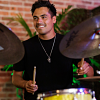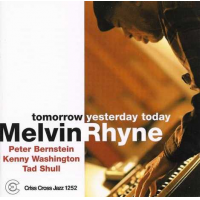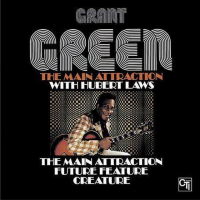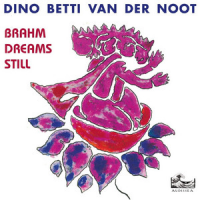Home » Jazz Articles » Liner Notes » Meridian Odyssey: Second Wave
Meridian Odyssey: Second Wave
Seattle became the nexus of this convergence of talent within a divergence of storylines. Young tenor phenom Santosh Sharma grew up in the Emerald City, and was a part of the nationally recognized jazz program at Roosevelt High School. Bassist Ben Feldman is a native Seattleite as well, having attended the rival jazz super program at Garfield HIgh School. Drummer Xavier Lecouturier, and pianist Dylan Hayes, attended high school together in Marin County, California, and migrated north to study at Seattle's Cornish College of the Arts. Guitarist Martin Budde dropped down from the small town of Big Lake, Alaska, to study at Cornish as well. While the coordinates of time and place brought these five musical souls together in Seattle by chance, the actual music between them can be traced back to Lecouturier playing weekly with Feldman, when the young bassist was just a sophomore at Garfield.
"Ben and I played duo weekly for like three years," recalls Lecouturier. "Me and Ben's lock-up is pretty insane these days. We've practiced duo with the metronome so many times."
Sharma left Seattle after high school to study at the prestigious Manhattan School of Music in New York City, followed two years later by Feldman. When home in Seattle, they were often seen in the company of Lecouturier, Hayes and Budde, in various configurations. Lecouturier spent his senior year at Cornish playing drums with the Thomas Marriott Quintet, a real life dose of the oral tradition that benefited the then twenty year old drummer in a very broad sense.
With Lecouturier and Sharma now graduated and on the loose, and Feldman also gaining professional notoriety, plans were put in place in early 2020 to tour and record. All three had been writing prolifically as well, with Lecouturier's efforts resulting in Carrier (Origin, 2019), an album of original compositions on the highly regarded Origin Records label. Hayes had taken over the legacy of Seattle big band legend Jim Knapp, having acquired the necessary skills to write and arrange for both small and large ensembles.
With all five set to head out on their journey in music, the Covid-19 pandemic had other ideas. Like the rest of the music and entertainment business, the five fell victim to a complete shutdown of live music venues, and most aspects of public life in general. It couldn't have come at a worse time. Their options were now seemingly in a complete holding pattern. Nonetheless, their story was in fact, just beginning.
While his bandmates were spending their formative years as musicians in or near the major west coast cities of San Francisco and Seattle, Budde was growing up north of Anchorage, Alaska in a small town of barely two thousand souls. Big Lake, Alaska is a remote village between Anchorage and Wasilla, a retreat from the torrent of human activity that typically envelops the city of Seattle where he had gone to seriously study and engage as a jazz musician. With he and Lecouturier feeling the financial crunch brought on by the global pandemic, the two headed to Big Lake to chill and plot their next course of action once the world returned to a semblance of normalcy. The idea was to stay with Budde's father, a pilot who owns several planes, and lay low for a while.
With the airline industry in the throes of economic hardship, low fares to Alaska became common, and Lecouturier came up with an idea to have some of their musician friends fly up and isolate with them in Big Lake. The two set up shop in a hangar that housed a plane Budde's father had used as a fish spotter, leading fishing boats to schools of fish in the Gulf of Alaska and Cook Inlet. Over the course of the summer, they streamed performances in different configurations, appropriately dubbing them, "The Hangar Sessions." When the assemblage was pared down to Hayes, Feldman and Sharma joining Lecouturier and Budde, all five participants had a revelation about a band that needed to tour, and spend some time in the studio.
"The first time we played in this configuration was in Alaska, we immediately knew that this was a band. The group chemistry was there in such a ridiculous way," recalls Feldman.
That feeling was in sharp contrast to earlier feelings of frustration and helplessness as a result of broken plans caused by Covid-19. Bassist Feldman, an ascendent and highly motivated musician and composer at just twenty one years of age, initially felt crushed by the weight of the epic period he was entering in his young life. Music didn't seem quite as important as it had since his introduction to jazz while in middle school.
"It was at a time when I thought everything was ramping up, and about to work out in New York, then suddenly everything was on pause. That was tough to deal with, but I think I'm at peace with that now," says Feldman.
Repose quickly turned into focus, and the quintet began to set up to create a recording environment in the hangar. Ever the eclectic soul, Lecouturier blended into the social fabric of the moment by working towards his pilot's license, taking in the magnificence of the Alaskan wilderness from the air, all the while composing and working on his craft behind the kit.
The band self engineered a recording of original compositions contributed by quintet members, along with a Hayes arrangement of a Knapp pearl. Adjustments were made to amend the imbalances of the room itself, producing surprisingly excellent results. The files were sent off to Floyd Reitsma in Seattle for mixing, and eventually to Dan Dean for mastering. Somehow in the midst of a world turned upside down, in a remote airplane hangar on the edge of the Alaskan wilderness, this fivesome of young talent had produced a recording of such quality as to submit it for release on Origin Records. The music carried an emotional honesty fully exposed by the twists and turns of living the jazz life in 2020.
"I think the vibe of the record is like 60's records, lots of energy and way more open, with room to improvise," cites Lecouturier, referring to the complexity and density of his compositions on Carrier. For Budde, at twenty five years of age the elder member of the quintet, bonding in music and friendship was the tonic for alleviating the anxious and stressful moments of these difficult and uncertain times. "When all these guys came up and rehearsed, I finally relaxed. I think the music is really reflective of that. It's a little humorous, it's not all intense," he says.
The sound of the session carries the vibe of all the contributing factors that convalesce to bring to life Lecouturier's original idea. There is an aire of isolationism, of primal focus on the task at hand. There is a sense of surrender to the circumstances of the times, and the healing that friendship and music can impose upon it.
From the first chorus of Lecouturier's "Interlake," we hear the ambient contribution of the room itself, a slight reverberance that makes each note seem like it is floating on air. Hayes' electric piano and Feldman's finely articulated bass line provide parameters for Lecouturier's polyrhythms, with Budde and Sharma finding emotional touchpoints within the harmony. The commonality of language acquired through hours of musical conversation between this group of friends seems to rise quickly to fruition, producing immediate results for the listener.
The Budde/Hayes composition, "Quarantine Blues," and Sharma's to the point, "Second Wave," bring to light the degree of separation between the music on this album, and Lecouturier's last outing on Origin. Intricate melodies lead to a wide open canvas for each participant to interpret with thick, broad strokes, and fine interconnecting lines. From the opening bold strokes of Feldman's bass, the stage is set for the soloists to weave their prose within a framework of personal and intuitive liberation.
Feldman's foray into neo-modernism, "For Antongiulio," stands apart for the visual qualities of the melody. Accompanied by Lecouturier, pianist Gus Carns and guitarist Lucas Winter, the piece has a folk-like feel, accentuated by riveting solos from Feldman and Sharma.
Meridian Odyssey is certainly a band to keep a collective eye on as time swings by, yet it would be advised to be focused on the individuals within the collective. They are five brilliant and focused musicians who against odds imposed by history and impossibility, have risen to the occasion to create art that provides depth, joy and emotional outreach in times of isolation and hardship. It allows the listener to focus on the dance of life's twists and turns, and the beauty that is its intuitive partner.
Liner Notes copyright © 2026 Paul Rauch.
Second Wave can be purchased here.
Contact Paul Rauch at All About Jazz.
I am a writer, producer and coordinator in the jazz community, living in Seattle.
Track Listing
Interlake; F Minus; Quarantine Blues; Looking Ahead; NT; For Antongiulio; Second Wave.
Personnel
Meridian Odyssey
band / ensemble / orchestraSantosh Sharma
saxophone, tenorMartin Budde
guitarDylan Hayes
keyboardsBen Feldman
bassXavier Lecouturier
drumsAdditional Instrumentation
Lucas Winter: guitar (7); Gus Carns: piano (7).
Album information
Title: Second Wave | Year Released: 2021 | Record Label: Origin Records
Tags
About Meridian Odyssey
Instrument: Band / ensemble / orchestra
PREVIOUS / NEXT
Support All About Jazz
 All About Jazz has been a pillar of jazz since 1995, championing it as an art form and, more importantly, supporting the musicians who make it. Our enduring commitment has made "AAJ" one of the most culturally important websites of its kind, read by hundreds of thousands of fans, musicians and industry figures every month.
All About Jazz has been a pillar of jazz since 1995, championing it as an art form and, more importantly, supporting the musicians who make it. Our enduring commitment has made "AAJ" one of the most culturally important websites of its kind, read by hundreds of thousands of fans, musicians and industry figures every month.























